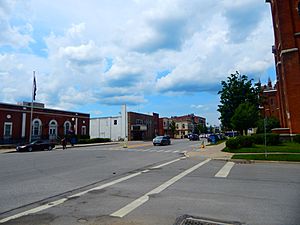Warsaw (village), New York facts for kids
Quick facts for kids
Village of Warsaw
|
|
|---|---|
|
Village
|
|

Downtown Warsaw along NY 19 in June 2015.
|
|
| Country | United States |
| State | New York |
| County | Wyoming |
| Town | Warsaw |
| Settled | 1803 |
| Incorporated | April 17, 1843 |
| Named for | Likely Warsaw, Poland |
| Area | |
| • Total | 4.11 sq mi (10.63 km2) |
| • Land | 4.11 sq mi (10.63 km2) |
| • Water | 0.00 sq mi (0.00 km2) |
| Elevation | 1,014 ft (309 m) |
| Population
(2020)
|
|
| • Total | 3,646 |
| • Density | 887.97/sq mi (342.86/km2) |
| Time zone | UTC-5 (EST) |
| • Summer (DST) | UTC-4 (EDT) |
| ZIP code |
14569
|
| Area code(s) | 585 |
| FIPS code | 36-78333 |
| GNIS feature ID | 0968827 |
Warsaw is a small village located in Wyoming County, New York, United States. It is also the main town, or county seat, for Wyoming County. The village is found near the center of the larger Town of Warsaw, nestled in a valley.
In 2020, about 3,646 people lived in Warsaw. If you're looking to continue your education, there's a branch of Genesee Community College right here in Warsaw.
Contents
History of Warsaw Village
The village of Warsaw officially became a village in 1843. Many important buildings in the village are recognized for their history. These include the Monument Circle Historic District, the Warsaw Downtown Historic District, the Seth M. Gates House, Trinity Church, the U.S. Post Office, and the Warsaw Academy. These places are listed on the National Register of Historic Places because they are historically important.
Warsaw's Role in Ending Slavery
Before the American Civil War, Warsaw was a very active place for people who wanted to end slavery. This movement was called abolitionism.
- In 1833, Warsaw started its own local group against slavery. This was the same year a big national anti-slavery group was formed.
- Many homes and churches in Warsaw helped enslaved people escape to freedom through the Underground Railroad. This was a secret network of safe houses.
- In November 1839, a political party called the Liberty Party was created in Warsaw's Presbyterian Church. This party was formed to fight against slavery.
- Important abolitionists from the area, like Seth M. Gates and Augustus Frank, served in the United States Congress. They worked to end slavery.
- A newspaper called The American Citizen, which was against slavery, was also published in Warsaw.
Geography of Warsaw
Warsaw is about 4.1 square miles (10.7 square kilometers) in size, and all of it is land.
The Oatka Creek is a stream that flows north through the village. Warsaw is located in a flat area known as the Wyoming Valley, which the creek runs through.
Population Changes in Warsaw
| Historical population | |||
|---|---|---|---|
| Census | Pop. | %± | |
| 1870 | 1,631 | — | |
| 1880 | 1,910 | 17.1% | |
| 1890 | 3,120 | 63.4% | |
| 1900 | 3,048 | −2.3% | |
| 1910 | 3,206 | 5.2% | |
| 1920 | 3,622 | 13.0% | |
| 1930 | 3,477 | −4.0% | |
| 1940 | 3,554 | 2.2% | |
| 1950 | 3,713 | 4.5% | |
| 1960 | 3,653 | −1.6% | |
| 1970 | 3,619 | −0.9% | |
| 1980 | 3,619 | 0.0% | |
| 1990 | 3,830 | 5.8% | |
| 2000 | 3,814 | −0.4% | |
| 2010 | 3,473 | −8.9% | |
| 2020 | 3,646 | 5.0% | |
| U.S. Decennial Census | |||
In 2000, there were 3,814 people living in Warsaw. The village had 1,484 households.
The population included people of all ages. About 23.8% were under 18 years old. About 21.7% were 65 years old or older. The average age of people in Warsaw was 39 years.
Education in Warsaw
All of the village of Warsaw is part of the Warsaw Central School District. This district provides education for students living in the area.
Images for kids
See also
 In Spanish: Warsaw (villa) para niños
In Spanish: Warsaw (villa) para niños



